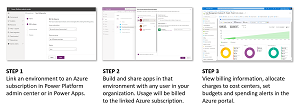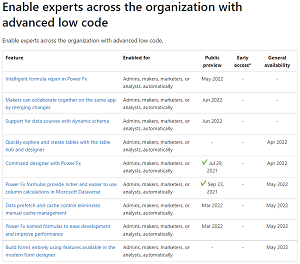News
Low-Code Microsoft Power Apps Gets Pay-as-You-Go Plan via Azure Subscription
Power Apps, Microsoft's low-code development service, is now available in a pay-as-you-go plan linked to an Azure cloud subscription.
Power Apps is the low-code development component of Microsoft's larger Power Platform, which also includes offerings for Business Intelligence and other functionality.
Power Apps is a suite of apps, services and connectors -- as well as a data platform -- that act as a service for building and using custom business apps that connect to data and work across the web and mobile, obviating the time and expense of custom software development. It's part of the burgeoning low-code/no-code, rapid application development market that has exploded in the face of increased demand for enterprise applications amid a dearth of experienced professional coding talent able to harness the greater power of more advanced tools like Visual Studio and VS Code. The movement to "democratize" app development uses a variety of DIY techniques, including wizards, templates, drag-and-drop functionality and model-driven development.
Previously, organizations paid for the Power Apps service by purchasing and allocating licenses in advance. Microsoft on March 8 announced the new flexible way to pay for Power Apps and related Power Platform services where Azure subscriptions can be used to cover Power Apps usage and Dataverse capacity costs based on actual usage.
"Historically, low-code platforms have required customers to figure out their licensing needs in advance -- often involving time-consuming procurement processes negotiated between developers, makers and IT professionals," Microsoft said. "While there are many benefits to the scale and predictability of user-based licensing, several scenarios today require the agility of a usage-based model. With deep roots in both Microsoft 365 as well as Azure, Power Platform is uniquely equipped to offer customers both options."
 [Click on image for larger view.] How It Works (source: Microsoft).
[Click on image for larger view.] How It Works (source: Microsoft).
As the graphic above illustrates, the new scheme involves linking an environment to an Azure subscription, after which created apps will be paid for according to their usage as determined by meters that measure running apps, Dataverse storage consumed and associated Power Platform requests, which Microsoft formerly called "API calls."
Microsoft said common use cases for the new pay scheme include:
- Widely distributed apps: Use the pay-as-you-go plan for apps that need to be shared with a large user base with infrequent and/or unpredictable use.
- Establish usage patterns: Understand adoption patterns for new apps to determine whether prepaid licenses make financial sense for your business.
- Flexible purchasing: Use an Azure subscription for Power Apps to reduce license procurement overhead and consolidate with other service purchases. This is especially helpful if you already have an Azure subscription that you use for other Microsoft services.
"The pay-as-you-go option for Power Apps is a great solution for developers who are already using Azure subscriptions to pay for the cloud services they need for their applications," Microsoft said. "Let's say you are planning to build a Power Apps mobile app that leverages Dataverse as well as a set of Azure-hosted APIs. Today you would need to purchase Power Apps licenses from Microsoft or a partner, and allocate those licenses before deploying your app , and also pay for the Azure services you are using with your Azure subscription. Now, with Power Apps pay-as-you-go you can simply use the same Azure subscription you are using to pay for your Azure services to pay for Power Apps as well."
As far as changes to the functionality of the offering, Power Apps is developed in waves, with the 2021 release wave 2 plan ending this month and the 2022 release wave 1 plan starting in April.
 [Click on image for larger view.] Part of the Roadmap (source: Microsoft).
[Click on image for larger view.] Part of the Roadmap (source: Microsoft).
Documentation of "What's new and planned for Power Apps" details what's coming in that wave, with one part of the documentation pictured above.
"Looking forward we plan to introduce capabilities like APIs to link environments to Azure subscriptions, and integration with the Power Platform Center of Excellence Starter Kit," Microsoft said in this week's announcement. "Longer term we have a range of services that would make sense to offer in a pay-as-you-go model and would love your input on where we should focus our efforts next."
About the Author
David Ramel is an editor and writer for Converge360.